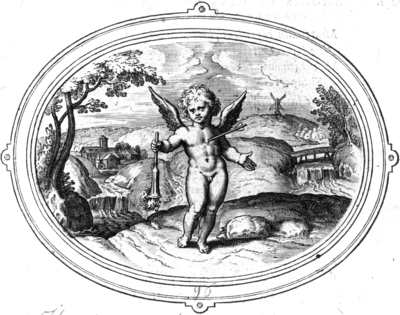Otto Vaenius, Amorum emblemata (1608)
Table of contents ↑Quod nutrit, extinguit [96]

Translations
 |
[Heinsius, Emblemata amatoria 5.1/5.3]. Wat me voedt, dooft me ook. |
 |
[Heinsius, Emblemata amatoria 5.1/5.3]. What feeds me, extinguishes me. |
 |
Zoals een fakkel door het vet waarmee hij wordt gevoed, ook weer dooft, zo kom ik om door wie ik leef en sterf door degene
op wie ik smoorverliefd ben. |
 |
As a torch is extinguished by the fat that feeds it, thus who gives me life, feeds me and infatuates me engenders my death. |
Sources and parallels
- Latin quote, Latin and French mottoes, pictura: Qui me nourrist, m’estaind [5]
 (in: Daniël Heinsius, Emblemata amatoria (1607/8)
(in: Daniël Heinsius, Emblemata amatoria (1607/8) )
[Compare
)
[Compare ]
]
- Jezus holding a torch in: De verlichte Ziele spreeckt, hoe, of op welck een wijse dat Godt de sonden vergeeft [15]
 (in: Jan Luyken, Jesus en de ziel (1685)
(in: Jan Luyken, Jesus en de ziel (1685) )
[Compare
)
[Compare ]
]
- Torch, head down: Amor, tela penelopes. [44]
 (in: Jacob Cats, Sinne- en minnebeelden (1627)
(in: Jacob Cats, Sinne- en minnebeelden (1627) )
[Compare
)
[Compare ]
]
- Parallel in an affixio: Porteman, Emblematic exhibitions
 , pp. 174-175
, pp. 174-175 -
A Parallel for the motto and the main pictorial element (mirrored): Qui me nourrist, m'estaind. [29]
 (in: Daniël Heinsius, Ambacht van Cupido, from: Nederduytsche poemata (1616)
(in: Daniël Heinsius, Ambacht van Cupido, from: Nederduytsche poemata (1616) )
[Compare
)
[Compare ]
]
-
A Parallel (and probably source) for the emblem (motto, Latin subscriptio and pictura): Qui me nourrist, m’estaind [5]
 (in: Daniël Heinsius, Quaeris quid sit Amor (c. 1601)
(in: Daniël Heinsius, Quaeris quid sit Amor (c. 1601) )
[Compare
)
[Compare ]
]
-
Parallel for the pictura (mirrored) and the Latin and French motto in: Un Amour tenant un Flambeau la flamme en bas, & percé d’une Fléche
 (in: Daniel de la Feuille, Devises et emblemes (1691)
(in: Daniel de la Feuille, Devises et emblemes (1691) )
[Compare
)
[Compare ]
]
References, across this site, to this page:
- Amor, tela penelopes. [44]
 (in: Jacob Cats, Sinne- en minnebeelden (1627)
(in: Jacob Cats, Sinne- en minnebeelden (1627) )
)
- Un Amour tenant un Flambeau la flamme en bas, & percé d’une Fléche
 (in: Daniel de la Feuille, Devises et emblemes (1691)
(in: Daniel de la Feuille, Devises et emblemes (1691) )
)
- Qui me nourrist, m’estaind [5]
 (in: Daniël Heinsius, Quaeris quid sit Amor (c. 1601)
(in: Daniël Heinsius, Quaeris quid sit Amor (c. 1601) )
)
- Qui me nourrist, m’estaind [5]
 (in: Daniël Heinsius, Emblemata amatoria (1607/8)
(in: Daniël Heinsius, Emblemata amatoria (1607/8) )
)
- Qui me nourrist, m'estaind. [29]
 (in: Daniël Heinsius, Ambacht van Cupido (1613)
(in: Daniël Heinsius, Ambacht van Cupido (1613) )
)
- Qui me nourrist, m'estaind. [29]
 (in: Daniël Heinsius, Ambacht van Cupido, from: Nederduytsche poemata (1616)
(in: Daniël Heinsius, Ambacht van Cupido, from: Nederduytsche poemata (1616) )
)
- De verlichte Ziele spreeckt, hoe, of op welck een wijse dat Godt de sonden vergeeft [15]
 (in: Jan Luyken, Jesus en de ziel (1685)
(in: Jan Luyken, Jesus en de ziel (1685) )
)

